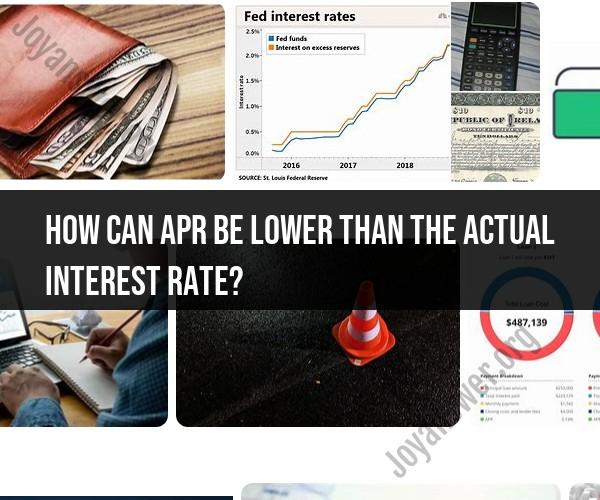How can Apr be lower than the actual interest rate?
An Annual Percentage Rate (APR) can be lower than the actual interest rate on a loan due to the way the APR is calculated and the inclusion of certain fees and costs associated with borrowing money. The APR is designed to provide borrowers with a more comprehensive and accurate understanding of the total cost of borrowing. Here's why the APR can be lower than the nominal interest rate:
Inclusion of Fees: The APR takes into account not only the interest charged on the loan but also certain fees and costs associated with the loan. These fees can include origination fees, points, broker fees, and other finance charges. When these fees are added to the total cost of the loan, it can make the effective interest rate (APR) higher than the nominal interest rate.
Amortization: In some cases, loans may have a front-loaded interest structure, where a significant portion of the interest is paid early in the loan term. This can result in a lower APR because the weighted average of the interest payments over the life of the loan may be lower than the nominal interest rate.
Discount Points: If you pay "points" to reduce the interest rate on a mortgage, those points can affect the APR. Paying points upfront can lower the nominal interest rate, which, in turn, can lead to a lower APR.
Lender Credits: On the other hand, some lenders may offer "lender credits" to borrowers, which can offset some of the upfront costs of the loan. These credits can lead to a lower APR because they effectively reduce the total cost of borrowing.
Variable Interest Rates: Loans with variable interest rates, such as adjustable-rate mortgages (ARMs), can have initial interest rates that are lower than the APR. Over time, as the interest rate adjusts, the APR can increase to reflect the total cost of borrowing.
Regulatory Requirements: Regulations in some regions or countries require lenders to calculate and disclose APR to ensure transparency and consumer protection. These regulations may dictate the specific methodology used to calculate APR.
It's essential for borrowers to pay attention to both the nominal interest rate and the APR when evaluating loan offers. While the nominal interest rate represents the cost of borrowing the principal amount, the APR provides a more accurate picture of the overall cost of the loan, including fees and other costs. This allows borrowers to make more informed decisions about which loan offer is the best fit for their financial needs and circumstances.
The three titles you have provided highlight the fact that APR can be lower than the actual interest rate. This can be confusing for consumers, but it is important to understand why this happens.
Demystifying APR: How It Can Be Lower Than the Actual Interest Rate
APR stands for Annual Percentage Rate. It is a measure of the cost of borrowing money, and it includes both the interest rate and any fees associated with the loan. The APR is calculated over a period of one year, and it is used to compare the costs of different loans.
In some cases, the APR may be lower than the actual interest rate. This can happen for a few reasons. One reason is that the APR may be calculated using a declining balance method. This means that the interest is calculated on the remaining balance of the loan, which decreases over time. As a result, the APR may be lower than the actual interest rate, especially in the early years of the loan.
Another reason why the APR may be lower than the actual interest rate is that lenders may offer discounts or rebates on certain loans. For example, a lender may offer a discount on the interest rate for borrowers who have good credit or who make a down payment on a loan. These discounts can lower the APR, even if the actual interest rate remains the same.
The Intricacies of APR: Understanding the Factors Behind Its Calculation
The APR is calculated using a complex formula that takes into account a number of factors, including the interest rate, the loan amount, the loan term, and any fees associated with the loan. The formula is designed to provide a more accurate picture of the true cost of borrowing money than the interest rate alone.
The following factors are considered in the calculation of APR:
- Interest rate: The interest rate is the percentage of the loan amount that the borrower must pay in interest over the life of the loan.
- Loan amount: The loan amount is the total amount of money that the borrower borrows.
- Loan term: The loan term is the length of time that the borrower has to repay the loan.
- Fees: Fees are any charges associated with the loan, such as origination fees, appraisal fees, and closing costs.
Deciphering Loan Costs: When and Why APR Differs from the Interest Rate
The APR will differ from the interest rate in the following situations:
- When the loan has fees associated with it.
- When the loan is a variable-rate loan.
- When the loan is a deferred-payment loan.
Variable-rate loans have interest rates that can fluctuate over time. This means that the APR for a variable-rate loan may be higher or lower than the actual interest rate, depending on the current interest rate environment.
Deferred-payment loans are loans that allow the borrower to defer making payments for a period of time. During the deferral period, the interest will continue to accrue, and it will be added to the principal balance of the loan. This will increase the APR for the loan, even if the actual interest rate remains the same.
It is important to note that the APR is just one factor to consider when choosing a loan. Other factors, such as the interest rate, the loan term, and the fees associated with the loan, should also be considered. Consumers should compare the APRs of different loans before choosing a loan, and they should ask their lender about any fees that may be associated with the loan.













